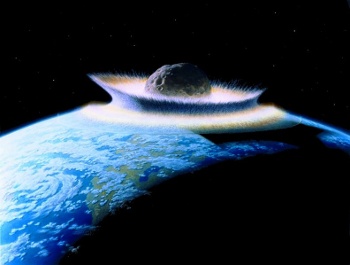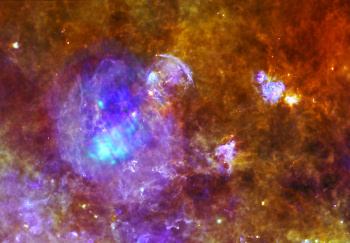Cosmic Ray Source
February 20, 2013
We live in a very
energetic universe, as the recent
Chelyabinsk meteor demonstrates. This interloper from
outer space entered
Earth's atmosphere at an estimated 15 - 18
km/sec. Such speed pales in comparison with that of the most energetic bits of matter in the universe,
cosmic rays, which travel at nearly the
speed of light (300,000 km/sec).

As Homer Simpson so famously asked his wife, Marge, "Which b'ak'tun is it?"
This is an artist's conception of the impact of a 1000 kilometer-diameter planetoid on primordial Earth.
(Illustration by Don Davis, via Wikimedia Commons.)
As I've written in a
previous article (Local Dark Matter/A Hundred Years of Cosmic Rays, August 17, 2012), cosmic rays were discovered a hundred years ago by the
Austrian scientist,
Victor Hess. Hess shared the 1936
Nobel Prize in Physics for his discovery.[1] What's surprising is that after a hundred years there are still some unknown things about cosmic rays.
Cosmic rays are
nuclei of the
elements, usually just
hydrogen nuclei (
protons), that apparently travel for millions of years at near-light speed before they reach the
Earth. Although
supernovas have been the leading contenders as cosmic ray emitters, there are quite a few
cosmic ray observatories in operation, today, trying to decide, exactly, what's responsible for this
isotropic influx of
radiation on Earth.[1]
Most
scientists believe that
galactic cosmic rays originate from supernovas or some process involving
black holes, simply because these are the highest energy objects in the galaxy.[3-4,6-7] After all, these cosmic ray particles have energies thousands of time higher than those produced by the
Large Hadron Collider.[3-4,6] Detection would be easy, were it not for the complicating influence of the
magnetic fields that permeate
interstellar space. Protons comprise about 90% of cosmic rays. Since they are
charged, their paths are distorted by magnetic fields.[3-4,8]
A new study, four years in the making by 169 scientists from 75 institutions, has tackled the problem by instead looking at a
gamma ray signature of cosmic rays.[2-9] Gamma rays are not affected by magnetic fields. The enabling technology for this study was
NASA's Fermi Gamma-ray Space Telescope, which was focused on two
supernova remnants thousands of
light years from Earth.[6-8]
The detection involves the interaction of cosmic ray protons with interstellar material to produce
neutral pions. The pions, which are composed of a
quark-
antiquark pair, quickly
decay into two gamma rays at a characteristic energy.[2-5,8] The characteristic energy helps to sort this particular process from others, such as
Bremsstrahlung and
inverse Compton scattering.[2,4-5]

Supernova remnant W44 is seen in this image as the purple patch about 100 light-years across.
(NASA image, Herschel SPIRE/PACS/ESA consortia and ESA/XMM-Newton .)
The necessary data collection was made possible by the Fermi Gamma-ray Space Telescope, launched in June 2008. Fermi is a collaboration between NASA, the
US Department of Energy, and scientists in
France,
Germany,
Italy,
Japan, and
Sweden.[8] Fermi observed two
supernova remnants (SNRs),
IC 443 and W 44.[2] Supernova remnants IC 443 and W 44 are 5,000 and 10,000 light years distant from Earth, and each of these have strong gamma ray emission in the range expected for pion decay.[3-4,8]
As the study reveals, the
acceleration of the cosmic ray particles to near-light speed is not from the supernova explosion, itself, but in the
shockwave of the remnant.[3,6] The shockwave
compresses the surrounding
gas, strengthening the magnetic fields present. Charged particles will traverse the shockwave region repeatedly, gaining energy at each passage, over the course of thousands of years by a process called
Fermi acceleration.[3-4,7-8] It's estimated that up to thirty percent of the
kinetic energy of the supernova is transferred to cosmic ray protons.[8]

Images of the shockwave region of supernova remnant SN 1006 from the Visible Multi-Object Spectrograph of the European Southern Observatory Very Large Telescope. (European Southern Observatory Image.)[9)]
As the 169 scientists of this study will attest, these data are from the pion decay, not another mechanism, and they validate the SNR shockwave mechanism for cosmic ray acceleration.[5] Are all cosmic ray mysteries now explained? Probably not, since 2011 cosmic-ray observations by the
Payload for Antimatter Matter Exploration and Light-nuclei Astrophysics (PAMELA) instrument aboard the
Resurs-DK1 satellite revealed an unexpected rise in cosmic ray
flux at very high energies. Cosmic rays might also be accelerated by objects other than SNRs.[4]
In particular, very high energy cosmic rays may emanate from
jets associated with black holes.[3] Also, this study was just on galactic cosmic rays, but ultra-high energy cosmic rays are thought to have
extragalactic origin.[5]. One example of an extremely energetic cosmic ray is the
Oh-My-God particle, detected to have an energy of 3 x 10
20 eV. This is 40 million times that of a Large Hadron Collider proton.
References:
- Alan Watson, "100 years of cosmic rays," Physics World, Aug 1, 2012.
- M. Ackermann, M. et al., "Detection of the Characteristic Pion-Decay Signature in Supernova Remnants," Science, vol. 339, no. 6121 (February 15, 2012), pp. 807-811.
- Jonathan Amos, "Cosmic rays: Fermi telescope settles mystery of origin," BBC News, February 14, 2013.
- Maggie McKee, "Cosmic rays originate from supernova shockwaves," Nature News, February 15, 2013.
- Matthew Francis, "Supernova observations solve the mystery of cosmic-ray origins," Arstechnica, February 14, 2013.
- Hayley Dixon, "Scientists solve mystery of cosmic rays," Telegraph (UK), February 15, 2013.
- Olivia Moore, "SLAC scientists confirm source of cosmic rays," Stanford Daily, February 15, 2013.
- Pete Spotts, "Cosmic rays' mysterious origin? Supernovae to blame, study confirms," Christian Science Monitor, February 14, 2013.
- Clues to the Mysterious Origin of Cosmic Rays, European Southern Observatory Press Release No. eso1308, February 14, 2013.
Permanent Link to this article
Linked Keywords: Energy; energetic; universe; 2013 Russian meteor event; Chelyabinsk meteor; outer space; Earth's atmosphere; meter per second; km/sec; cosmic rays; speed of light; Homer Simpson; 2012 phenomenon; Marge Simpson; baktun; b'ak'tun; impact event; kilometer; diameter; planetoid; Earth; Don Davis; Wikimedia Commons; Austria; Austrian; Victor Hess; Nobel Prize in Physics; atomic nucleus; nuclei; chemical element; hydrogen; proton; supernova; cosmic ray observatory; isotropy; isotropic; radiation; scientist; galaxy; galactic; black hole; Large Hadron Collider; magnetic field; interstellar medium; interstellar space; charge; gamma ray; NASA; Fermi Gamma-ray Space Telescope; supernova remnant; light year; neutral pion; quark; antiquark; neutral pion decay; Bremsstrahlung; inverse Compton scattering; Herschel SPIRE/PACS/ESA consortia; ESA/XMM-Newton; US Department of Energy; France; Germany; Italy; Japan; Sweden; supernova remnant; IC 443; W 44; acceleration; shockwave; gas; compression; Fermi acceleration; kinetic energy; SN 1006; Visible Multi-Object Spectrograph; European Southern Observatory; Very Large Telescope; Payload for Antimatter Matter Exploration and Light-nuclei Astrophysics; Resurs-DK1 satellite; flux; relativistic jet; extragalactic cosmic ray; Oh-My-God particle; electronvolt; eV.